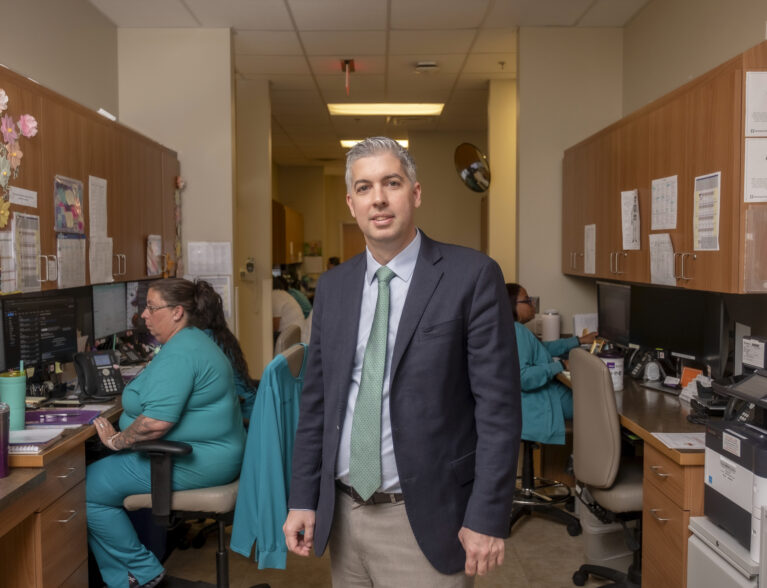
An estimated 6.7 million people (or 1 in 50) in the United States have an unruptured brain aneurysm. The annual rate of rupture is approximately 8 per 100,000 people, which means that 30,000 people in this country alone suffer a ruptured brain aneurysm rupture each year.
Happily, medical advances have led to a progressive new treatment for brain aneurysms: transorbital surgery, which is performed by Dr. Mauricio Mandel, MD, Ph.D., at Cleveland Clinic Tradition Hospital.
Dr. Mandel explains that a small incision is made in the eyelid – similar in placement and technique to that done in cosmetic surgery – in which he inserts a camera and clips the aneurysm in the same manner it’s done in traditional aneurysm surgery.
Transorbital trans-eyelid surgery accesses and treats anterior circulating aneurysms, including middle cerebral aneurysms (MCA), without performing a traditional craniotomy.
Mayo Clinic defines a brain aneurysm (also known as a cerebral aneurysm or intracranial) as a bulge or ballooning in a blood vessel in the brain. An aneurysm often looks like a berry hanging on a stem.
Experts think brain aneurysms form and grow because blood flowing through the blood vessel puts pressure on a weak area of the vessel wall. This can increase the size of the brain aneurysm.
If the brain aneurysm leaks or ruptures, it causes bleeding in the brain, known as a hemorrhagic stroke.
“Many small aneurysms don’t need to be treated,” explains Dr. Mandel. “We monitor them to check for changes, but people can go for years without treatment.
“It’s not unusual for people to be unaware they have one,” he says. “Most of the time, there are no symptoms, making it tricky if yours should get to the point where it needs treatment and you’re unaware of your condition.
“If the first warning is when it ruptures, it’s too late,” he continues.
Aneurysms are usually detected by MRI if someone is suffering with unexplained headaches or vertigo.
The National Institute of Neurological Disorders & Stroke notes that brain aneurysms can occur in anyone and at any age, but they are most common in adults between the ages of 30 and 60 and are more common in women than in men. People with certain inherited disorders are also at higher risk.
Plus, says Dr. Mandel, “if you do have a brain aneurysm, there’s a 17-times greater chance it will rupture if you’re a smoker.
“If you’ve never been told you have a brain aneurysm but develop a sudden headache, a ‘thunderclap’ kind of headache, the worst headache of your life, you should literally run to the hospital,” warns Dr. Mandel.
The Brain Aneurysm Foundation describes the two treatment options used by most doctors.
Open brain aneurysm surgery is necessary when aneurysms cannot be coiled, or flow diverted due to their location or other characteristics. Patients undergo general anesthesia for this surgery. An incision is made in the skin of the head and the skull is opened by removing a very small piece of bone, called a bone flap, so the aneurysm can be accessed directly.
Endovascular treatment doesn’t require general anesthesia or opening of the skull. The aneurysm is accessed via a catheter inserted into arteries in the arm or groin. Treatment consists of inserting small metal coils into the aneurysm, called coiling, or a newer technology called flow diversion that uses stents.
Then there’s the game-changing transorbital surgery practiced by Dr. Mandel, which basically can be used to treat any brain aneurysm requiring surgery. He’s one of a handful of surgeons in Florida to perform this procedure.
“Most patients are candidates for this surgery,” he explains. “It’s minimally invasive and patients recover quickly.” Other advantages include reduced operative times, shorter hospital stays, and a faster return to a normal lifestyle.
Dr. Mandel has spent decades studying and researching transorbital surgery. It was the subject of his doctoral dissertation, and he has taken part in – and led – many studies. “The success of this surgery is greatly dependent on the learning curve of the surgeon,” he explains.
Mauricio Mandel, M.D., Ph.D, obtained his medical degree, did his neurosurgery residency, got a clinical Ph.D. focused on Minimally Invasive Neurosurgery, and worked as an attending neurosurgeon in Brazil. In 2019, he moved to the United States, joined Stanford University as a clinical instructor and underwent further training in Epilepsy Surgery at Yale University. His office is located in Tradition HealthPark One, 10050 SW Innovation Way, Port St. Lucie, where he treats patients from the entire Treasure Coast. Call 877-463-2010 for an appointment.



